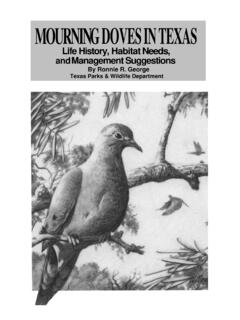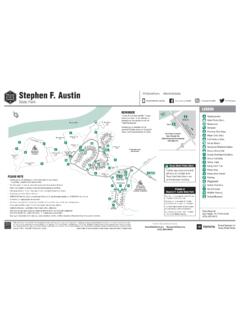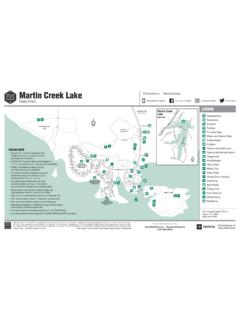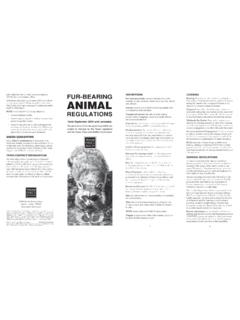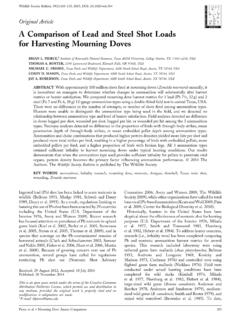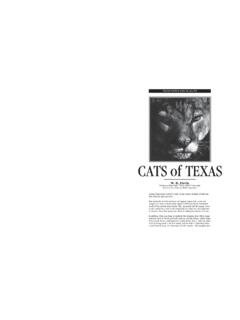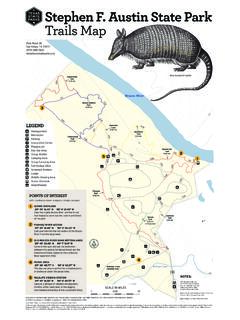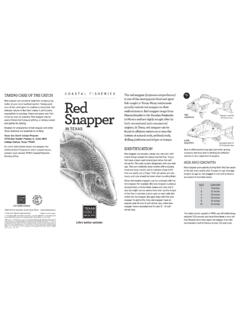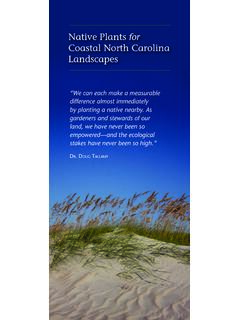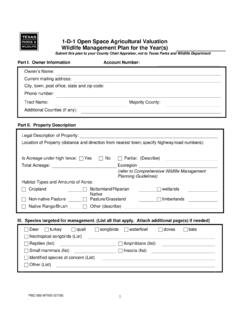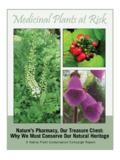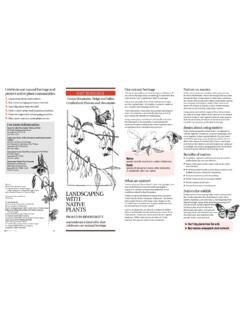Transcription of Identification of Milkweeds in Texas
1 Identification of Milkweeds in Texas Texas milkweed (Asclepias texana), courtesy Bill CarrCompiled by Jason Singhurst and Ben Hutchins Parks and Wildlife Department Austin, TexasandWalter C. of BiologyBaylor UniversityWaco, TexasIdentification of Milkweeds in TexasCreated in partnership with the Lady Bird Johnson Wildflower Center Design and layout by Elishea SmithCompiled by Jason Singhurst and Ben Hutchins Parks and Wildlife Department Austin, TexasandWalter C. of BiologyBaylor UniversityWaco, TexasIntroductionThis document has been produced to serve as a quick guide to the Identification of Milkweeds (Asclepias spp.) in Texas . For the species listed in Table 1 below, basic information such as range (in this case county distribution), habitat, and key Identification characteristics accompany a photograph of each species. This information comes from a variety of sources that includes the Manual of the Vascular Flora of Texas , Biota of North America Project, knowledge of the authors, and various other publications (cited in the text).
2 All photographs are used with permission and are fully credited to the copyright holder and/or originator. Other items, but in particular scientific publications, traditionally do not require permissions, but only citations to the author(s) if used for scientific and/or nonprofit purposes. Names, both common and scientific, follow those in USDA NRCS (2015).When identifying Milkweeds in the field, attention should be focused on the distinguishing characteristics listed for each species. Additionally, we would appreciate being provided with photographs to document iNaturalist observations which should focus on leaf shape characteristics (margins, surfaces, and arrangement; opposite, whorled or alternate), flowers (which are highly modified depending on species), and inflorescences (cyme, raceme, umbel, or occasionally flowers borne singly). Participants are encouraged to contact the authors via email as range maps (distributions) were created using the Biota of North American Project (BONAP, Kartez 2014) National Plant Atlas.
3 A state is dark green if a species occurs there and is native to the state. A state is brown if a species does not occur there. A state is blue if a species occurs there and is not native to the state. Light green counties indicate that the species occurs in a given county. Yellow counties indicate that the species is rare in the state and occurs in a given county. Non-native species which are shown in turquoise and are questionable presence records are indicated by cross-hatched otherwise indicated, statements concerning the distributions of species apply only to Texas . The genus Asclepias was formerly placed in the family Asclepiadaceae, which has been subsumed into the Apocynaceae. Finally, errors, corrections, and improvement suggestions are and non-native Milkweeds (Asclepias spp.) recorded from Texas . Non-native Milkweeds are noted with an asterisk (*) next to the species Name Scientific Name PageBlunt-leaf milkweed Asclepias amplexicaulis 6 Sand milkweed Asclepias arenaria 7 Antelopehorns Asclepias asperula 8 Bract milkweed Asclepias brachystephana 9 Tropical milkweed Asclepias curassavica (*)
4 10 Emory s milkweed Asclepias emoryi 11 Engelmann s milkweed Asclepias engelmanniana 12 Nodding milkweed Asclepias glaucescens 13 Swamp milkweed Asclepias incarnata 14 Dwarf milkweed Asclepias involucrata 15 Fewflower milkweed Asclepias lanceolata 16 Broad-leaf milkweed Asclepias latifolia 17 Slim milkweed Asclepias linearis 18 Longleaf milkweed Asclepias longifolia 19 Longhood milkweed Asclepias macrotis 20 Tufted milkweed Asclepias nummularia 21 Pineland milkweed Asclepias obovata 22 Zizotes Asclepias oenotheroides 23 Prostrate milkweed Asclepias prostrata 24 Shore milkweed Asclepias perennis 25 Plains milkweed Asclepias pumila 26 Purple milkweed Asclepias purpurascens 27 Red milkweed Asclepias rubra 28 Bear Mountain milkweed Asclepias scaposa 29 Showy milkweed Asclepias speciosa 30 Sperry s milkweed Asclepias sperryi 31 Slimleaf milkweed Asclepias stenophylla 32 Horsetail milkweed Asclepias subverticillata 33 Common milkweed Asclepias syriaca 34 Texas milkweed Asclepias texana
5 35 Velvet-leaf milkweed Asclepias tomentosa 36 Butterfly milkweed Asclepias tuberosa 37 Wheel milkweed Asclepias uncialis 38 Redring milkweed Asclepias variegata 39 Whorled milkweed Asclepias verticillata 40 Green comet milkweed Asclepias viridiflora 41 Green antelopehorn Asclepias viridis 42 Table 1 Floral and fruit characters of milkweeda) Inflorescence a) Flower b) Flower c) Flowering plantb) Flower with one hood and one horn removed c) Flower with all hoods and horns removed d) GynoeciumPhotos: Castner ) Immature follicles b) Follicles beginning of dehiscence c) Follicle at full dehiscence releasing seeds with tuft of hairs for dispersalPhotos: Castner : Armstrong 2002 Blunt-leaf milkweed (Asclepias amplexicaulis)Photos: Doug Goldman, hosted by the USDA-NRCS PLANTS Database/USDA-NRCS-NPDTH abitat: Longleaf Pine-Bluejack Oak sandhills and Shortleaf Pine-Bluejack Oak sandhills in east Texas , Sand Post Oak-Bluejack Oak sandhills in the Post Oak Savanna Ecoregion, sandhill terraces along the Red River in northeast Texas , and sandy prairies in northeast characteristics: Herbaceous perennials, the glabrous (hairless) stem has a whitish, waxy surface and reaches m in height; the sessile (stalkless) leaves that clasp the stem are distinctive among Milkweeds , being opposite, broadly ovate or oval to oblong-lanceolate, bases broadly cordate and clasping (amplexicaul, , embracing and surrounding the stem at base); inflorescences slender, terminal or solitary at the uppermost node; flowers greenish, corolla purple or rose.
6 Flowering: species: Asclepias amplexicaulis is similar to Asclepias syriaca, which has petiolate (stalked) leaves that do not clasp the stem, fruits (pods) with a bumpy surface and hairy stems. Asclepias syriaca is reported only in Randall County. Asclepias amplexicaulis is also similar to A. purpurascens, historically known in Texas only from Bowie County, is distinguished by its petiolate milkweed (Asclepias arenaria)7 Habitat: Dunes and sandhills in the High Plains, Rolling Plains, and Trans Pecos Ecoregions and deep sandhills ( blowouts ) in the southern Post Oak Savanna characteristics: Herbaceous perennials growing to 8 dm or more tall; leaves opposite, petiolate, densely tomentulose, very broadly obovate-oval and more or less subquadrate, uniform in size and shape, 6-9 cm long and 4-8 cm broad, somewhat cordate at bases; inflorescences lateral or solitary at several of the upper nodes; flowers pale-green.
7 Smells distinctly of bacon-cheeseburgers from a distance of up to 500 m. The smell is diagnostic for this : species: Asclepias arenaria is similar to A. speciosa, which has flowers 15-28 mm tall with pale rose to pinkish-cream gynostegia (fused reproductive parts). Asclepias arenaria has flowers 11-14 mm tall, hairy, green to purplish calyx lobes and pale green, and reflexed corolla lobes. The gynostegia are white to creamy and glabrous. Asclepias arenaria is also similar to A. viridiflora which has pale green gynostegia and no : Brenda K. Loveless (left), Norman G. Flaigg (right)Antelopehorns (Asclepias asperula)8 Habitat: Rocky and sandy prairies; Blackland Prairie, Edwards Plateau, Grand Prairie, Rolling Plains, High Plains, and Trans Pecos characteristics: Herbaceous perennials growing from stout rootstocks; stems usually clustered, ascending or somewhat decumbent, 2-6 dm tall; leaves are lanceolate to linear-lanceolate, 1-3 cm wide; inflorescences terminal, solitary, usually many-flowered, very crowded, and sessile to long-pedunculate; flowers pale-yellowish, sometimes slightly flushed with purple : species: Asclepias asperula is similar to A.
8 Viridis. Asclepias asperula typically has lanceolate to linear-lanceolate leaves that are narrowly acuminate at the apex while A. viridis leaves are broadly oblong to ovate and obtuse to shortly acute at apex. Asclepias asperula has a distribution that includes central, north central, and west Texas while A. viridis occurs in the eastern half of the Manual of the Vascular Plants of Texas (Correll and Johnston, 1970), Asclepias asperula is recognized as including two subspecies. One is A. asperula subspecies capricornu, based upon the reduction of A. capricornu Woodson (by Woodson himself) to the subspecies level under A. asperula. This reduction automatically created the name A. asperula subspecies asperula. The subspecies may be distinguished by the following key and comments quoted from Correll and Johnston (1970).1a. Inflorescences usually obviously and rather long-pedunculate; hoods usually rather dark purple; leaves usually asperulaPhotos: Brenda K.
9 Loveless (left), Norman G. Flaigg (right)Bract milkweed (Asclepias brachystephana)9 Habitat: Desert mountains, desert grasslands, and plains in igneous, sandy, and gypsum soils in the High Plains and Trans Pecos characteristics: Herbaceous perennials; stems 1-4 dm tall, clustered from a rootstalk, branching repeatedly upwards; inflorescences lateral and solitary at the upper nodes; flowers conspicuously white-tomentulose, rather small; corolla reflexed; reddish-purple or : species: : Russ Kleinman, Department of Natural Sciences and Dale A. Zimmerman Herbarium, Western New Mexico Inflorescences sessile or subsessile; hoods usually greenish-cream color; leaves usually more broadly lanceolate .. subsp. capricornuSubsp. asperula occurs mostly in w. capricornu (Woods.) Woods. occurs mostly in cen. mentioned differences between the two subspecies, accompanied by the differences in distributions, suggest (to the current authors) that the two subspecies may deserve recognition at the specific milkweed (Asclepias curassavica)Photos: Wikimedia CommonsHabitat: Non-native and naturalized in very south Texas (Cameron and Hidalgo counties) and southeast characteristics: Herbaceous perennials; stem to 9 dm; leaves narrow, pointed at tip, and 13-15 cm long; flowers very showy with yellow/orange corona and bright red corolla; fruits 8-10 cm long, spindle : species: Easily recognized by the bright red and yellow/orange flowers.
10 The species is often used in butterfly gardens. The flower color is suggestive of Asclepias tuberosa, but easily distinguished by comparison with the included s milkweed (Asclepias emoryi)11 Habitat: Grasslands in south Texas , western Edward s Plateau, and southern Rolling Plains. Usually growing in limestone, caliche, or sandy loam characteristics: Herbaceous perennials; stems ascending or decumbent, branched from base 1-2 dm tall, originating from clustered rootstalks; leaves, opposite, long petiolate, rhombic-ovate to narrowly oblong-lanceolate, 4-8 cm long and 4 cm wide; inflorescences lateral, solitary too few to several in the upper nodes; flowers pale-green to pale-greenish-cream; hoods blunt at apex, about 5 mm long, extending at least a third longer than anther : species: Asclepias emoryi is similar to Asclepias oenotheroides. The hoods of A. oenotheroides are bi-lobed while those of Asclepias emoryi are blunt (and unilobed).

